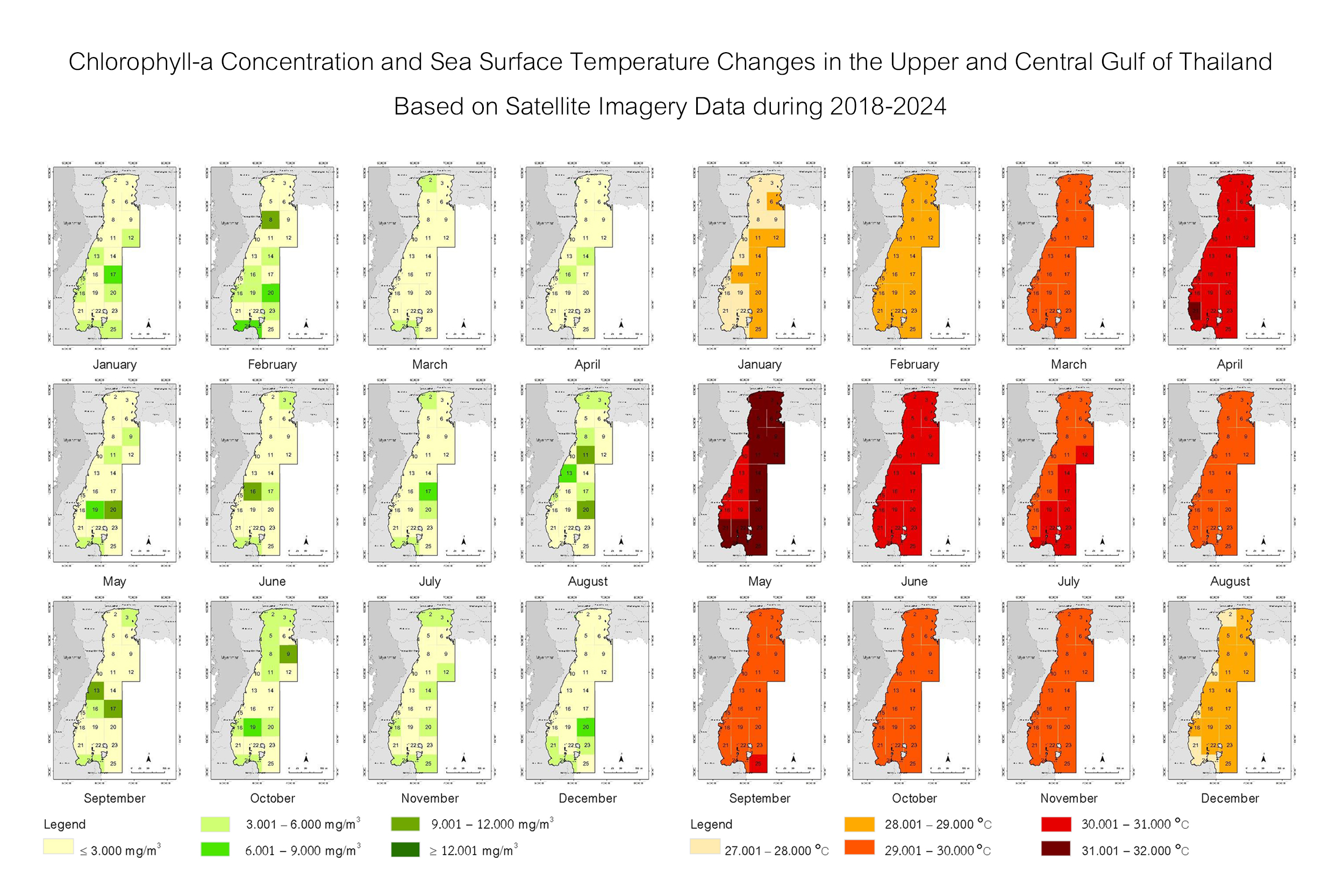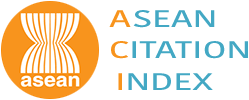Analyzing Chlorophyll-a Concentration and Sea Surface Temperature Changes in the Upper and Central Gulf of Thailand Based on Satellite Imagery Data during 2018-2024
Keywords:
chlorophyll-a , Sentinel-3 , satellite imagery , Upper and Central Gulf of Thailand , sea surface temperatureAbstract
Background and Objectives : Changes in the marine environment such as sea surface temperature (SST) can influence the physical, chemical, and biological processes of the sea and directly affect the growth and distribution of marine phytoplankton. This study analyzes the changes in the concentration of chlorophyll-a (Chl-a) and sea surface temperature in the inner and central Gulf of Thailand between 2018 and 2024 and aims to identify any relationship between them. This information can be beneficial in informing how satellite imagery data can be applied to assess the risk of climate change and to plan and manage marine and coastal resources more effectively, both spatially and temporally.
Methodology : The study area was divided into 25 grids to facilitate spatial analysis, covering the upper and central Gulf of Thailand by using ArcGIS Pro 3.3.0. Each grid was 55×55 kilometers. The total area of the 25 grids was 57,949 square kilometers. Chl-a concentration data was obtained by Sentinel-3 Ocean and Land Colour Instrument (OLCI) Level-2 products which had previously performed an atmospheric correction. Prior to downloading, data were filtered to include only images with cloud coverage not exceeding 20 percent. Additionally, SST data were obtained from satellite imagery provided by the Group for High Resolution Sea Surface Temperature (GHRSST). Both Chl-a and SST datasets for the period of 2018-2024 were downloaded on a weekly basis and subsequently processed using Sentinel Applications Platform (SNAP) version 10.0.0. The datasets were aggregated into monthly means prior to analysis. Annual variations in chlorophyll-a concentration and SST were examined using descriptive statistics to assess the degree of seasonal clustering. The Gini coefficient was applied to quantify the extent of intra-annual variability in both chlorophyll-a concentration and SST. Furthermore, the relationship between chlorophyll-a concentration and SST was evaluated using Spearman’s rank correlation analysis.
Main Results : The average monthly concentration of Chl-a fluctuated month-to month throughout the year and tended to increase year over year. During 2018-2020, Chl-a averaged 1.276 mg/m3 (SD = 0.514) per month. After 2020, annual Chl-a concentration increased to 3.419 mg/m3 (SD = 1.616) per month. SST fluctuated less throughout the year than the Chl-a concentration and tended to be more stable year to year. During 2018-2024, there was no change in annual SST variability nor did there appear to be any seasonality. The annual concentrations of Chl-a were found to have a Gini coefficient between 0.18 and 0.31. This reflects that Chl-a content has a greater annual variability than SST which has much lower Gini coefficients ranging from 0.014 to 0.022. This also demonstrates that the amount of Chl-a was concentrated in some months higher than SST, and is shows the consistency of SST values throughout the year. The results of the spatial analysis of chlorophyll-a concentrations across all 25 grids revealed that the upper Gulf of Thailand, particularly the coastal areas of Samut Songkhram and Phetchaburi provinces (Grid 1), had a high Chl-a concentration nearly throughout the year because it is a coastal area with shallow water and high ecological abundance. It is also influenced by freshwater flowing from the Mae Klong and Phetchaburi rivers flowing into Bang Taboon Bay which can result in the deposit of a substantial amount of sediment and nutrients. Sediment and nutrients are conducive to phytoplankton growth, especially during April to July when the average Chl-a was more than 12.000 mg/m3. During 2018-2023, most SSTs were in the range of 29.000-30.000 degree Celsius, while in 2024, SST increased significantly to more than 30.000 degree Celsius in the central Gulf of Thailand. The relationship between Chl-a and SST from January 2018 to December 2024, were inversely related at a statistically significant level of 0.05 (Z =-5.130, p < 0.05), exhibiting a low significant relationship at (rs=-0.076). In this regard, Spearman Rank Correlation was used to analyze the relationship between Chl-a concentration and SST during 2018-2020. It was found that they were inversely related at a statistically significant level of 0.05 (Z = -2.325, P = 0.020); increased SST reduce the density of the surface layer, enhancing thermal stratification. This stable stratification inhibits the vertical mixing and upwelling of nutrient-rich deep water to the sunlit surface layer. Consequently, the resulting nutrient limitation restricts phytoplankton growth and primary productivity exhibiting a low significant relationship at (rs = -0.051) as SST increase, Chl-a concentration tends to decrease. In 2021-2024, they remained inversely related at (rs = -0.063), reflecting a decreased relation level that is statistically significant level of 0.05 (Z = -3.129, p = 0.002). Conversely, a decrease in SST weakens the density gradient between the layers. This reduced stratification enhances vertical mixing, allowing nutrient-rich deep water to be transported to the surface. This nutrient enrichment (or nutrient replenishment) subsequently promotes phytoplankton growth leading to a corresponding increase in chlorophyll-a concentrations.
Conclusions : The results showed that during a given 12-month period, the monthly Chl-a average fluctuated throughout the year and tended to increase year-over-year. SST fluctuated less throughout a given year than the Chl-a concentration and tended to be more stable year-over-year during the time period that was subject to analysis. Chl-a concentration and SST had a low inverse relationship. The study results demonstrate the utility of applying satellite imagery data, particularly to rapidly assess large fishery resource areas and fishing grounds with a potential for restoration. Application of satellite imagery can assist in assessing fisheries or environmental circumstances, both spatially and temporally, and support planning for sustainable resource use in the future.
References
Behrenfeld, M. J., O'Malley, R. T., Siegel, D. A., McClain, C. R., Sarmiento, J. L., Feldman, G. C., Milligan, A. J., Falkowski, P. G., Letelier, R. M., & Boss, E. S. (2006). Climate-driven trends in contemporary ocean productivity. Nature, 444(7120), 752–755. doi.org/10.1038/nature05317
Buranapratheprat, A., & Annyadamiksuk, A. (2013). Temporal variation of surface chlorophyll-a concentration in the Andaman Sea derived from Aqua MODIS satellite imagery. Burapha Science Journal, 18(1), 194–201. (in Thai)
Chin, T. M., Vazquez-Cuervo, J., & Armstrong, E. M. (2017). A multi-scale high-resolution analysis of global sea surface temperature. Remote sensing of environment, 200, 154-169.
Dewi, C. D., Hidayat, M. N., Wafdan, R., Ramli, M., Muchlisin, Z. A., Rusydi, I., Muhammad, M., Rizal, S., Nanda, M., Ali Akbar, S., Prajaputra, V., & Haditiar, Y. (2024). Exploring the interplay of chlorophyll-a, sea surface temperature, and sea surface salinity in aceh waters during january and july 2022. BIO Web of Conferences, 87. doi.org/10.1051/bioconf/20248701001
EUMETSAT. (2021). Sentinel-3 OLCI Level-2 ocean colour products user guide. European Organisation for the Exploitation of Meteorological Satellites (EUMETSAT). Retrieved from https://www.eumetsat.int/olci-user-guide
European Space Agency. (2020). Sentinel-3 OLCI algorithm theoretical basis document: OLCI level-2 marine products (Issue 2.6, Ref. S3-L2-MAR-C-ATBD). ESA. Retrieved from https://sentinels.copernicus.eu
FAO. (2024). The State of World Fisheries and Aquaculture 2024 – Blue Transformation in action. FAO. doi.org/10.4060/cd0683en
Inthajaroen, P., Buranapratheprat, A., Morimoto, A., Jintasena, P., & La-ongmanee, W. (2018). A localized algorithm for analyzing surface chlorophyll-a using MODIS satellite data in the Upper Gulf of Thailand. Burapha Science Journal, 23(2), 608–623. (in Thai)
JPL MUR MEaSUREs Project. (2015). Multi-sensor advanced, high-resolution global sea surface temperature dataset (v4.1). Jet Propulsion Laboratory, California Institute of Technology. Retrieved from https://www.podaac.jpl.nasa.gov/dataset/JPL_MUR_Multi_Sensor_SST_V4.1
Laosuwan, T., Uttaruk, Y., & Rotjanakusol, T. (2022). Analysis of Content and Distribution of Chlorophyll-a on the Sea Surface through Datafrom Aqua/MODIS Satellite. Polish Journal of Environmental Studies, 31(5), 4711-4719. doi.org/10.15244/pjoes/150731
Luang-on, J., Ishizaka, J., Buranapratheprat, A., Phaksopa, J., Goes, J. I., Kobayashi, H., & Matsumura, S. (2022). Seasonal and interannual variations of MODIS Aqua chlorophyll-a (2003–2017) in the Upper Gulf of Thailand influenced by Asian monsoons. Journal of Oceanography, 78(4), 209-228.
Mekasampan, J. (2020). Mackerel migration routes in the Gulf of Thailand: Impacts from aquatic environmental problems. Faculty of Fisheries, Kasetsart University. (in Thai)
National Geographic Committee (Thailand). (1984). Geographical characteristics of the Gulf of Thailand. Office of the Prime Minister. (in Thai)
Rattanavijit, U., Tarnchalanukit, W., Chunkao, K., & Phewnil, O. (2019). Relationship between water qualities and phytoplankton at coastal area, Phetchaburi Province, Thailand. Burapha Science Journal, 24(1), 203–215. (in Thai)
Rakseree, S., Intacharoen, P., Gunboa, V., & Buranapratheprat, A. (2025). Monsoonal effects and hydro–biogeochemical characteristics in maritime cargo areas of Siracha Bay, eastern upper Gulf of Thailand. Journal of Fisheries and Environment, 49(2), 67–79. doi.org/10.34044/j.jfe.2025.49.2.05
Sasamal, S. K., Prasad, T. G., & Chauhan, P. (2005). Seasonal variability of chlorophyll concentrations in the Bay of Bengal observed from SeaWiFS. Current Science, 89(9), 1473–1477.
Solanki, H., Dwivedi, R., Nayak, S., Somvanshi, V., Gulati, D., & Pattnayak, S. (2003). Fishery forecast using OCM chlorophyll concentration and AVHRR SST: Validation results off Gujarat coast, India. International Journal of Remote Sensing, 24(18), 3691–3699.
Sukdanon, S. (2017). Ports in the inner Gulf of Thailand. Chulalongkorn University Transportation Institute. Retrieved from https://www.cuti.chula.ac.th/articles/478/ (in Thai)
Tang, D.L., Kawamura, H., Doan-Nhu, H., & Takahashi, W. (2004). Remote sensing oceanography of a harmful algal bloom off the coast of southeastern Vietnam. Journal of Geophysical Research: Oceans, 109(C3). doi.org/10.1029/2003JC002045
Tang, D. L., Kawamura, H., Doan-Nhu, H., & Takahashi, W. (2018). Remote sensing of phytoplankton blooms in the South China Sea. International Journal of Remote Sensing, 39(14), 4745–4765.
Thaiphichitburapha, P., Buranapratheprat, A., Kanbua, W., Chaipipatnakajorn, T., Kingkaew, N., & Intacharoen, P. (2024). Study on surface chlorophyll-a detection methods using Sentinel-3 satellite imagery along the coastal area of Trat Province. The Journal of Spatial Innovation Development, 5(2), 65–79. (in Thai)
Thongchub, P., & Chayakul, T. (2023). Relationship between sea surface temperature and chlorophyll-a concentration in the Upper Gulf of Thailand. In Proceedings of the 28th National Convention on Civil Engineering. (in Thai)
Tsitouras, A. (2004). Adjusted Gini coefficient and “months equivalent” degree of tourism seasonality: A research note. Tourism Economics, 10(1), 95–100.
Rattanavijit, U., Tarnchalanukit, W., Chunkao, K., & Phewnil, O. (2019). Relationship between Water Qualities and Phytoplankton at Coastal Area Phetchaburi Province, Thailand. Burapha Science Journal, 24(1), 203-215. (in Thai).
Wongrat, L. (1999). The role of phytoplankton as primary producers in aquatic ecosystems. Journal of Aquatic Ecology, 5(1), 15–24. (in Thai)
Untong, A., Ramos, V., Kaosa-ard, M., & Rey-Maquieira, J. (2011). The seasonal pattern and the effects of unexpected events on outbound Chinese tourism: The case of Chinese tourist arrivals to Thailand. The Second International Conference on Tourism between China-Spain (ICTCHS2011), March 27–31, 2011, Palma de Mallorca, Spain.

Downloads
Published
How to Cite
Issue
Section
License
Copyright (c) 2025 Faculty of Science, Burapha University

This work is licensed under a Creative Commons Attribution-NonCommercial-NoDerivatives 4.0 International License.
Burapha Science Journal is licensed under a Creative Commons Attribution-NonCommercial-NoDerivatives 4.0 International (CC BY-NC-ND 4.0) licence, unless otherwise stated. Please read our Policies page for more information



